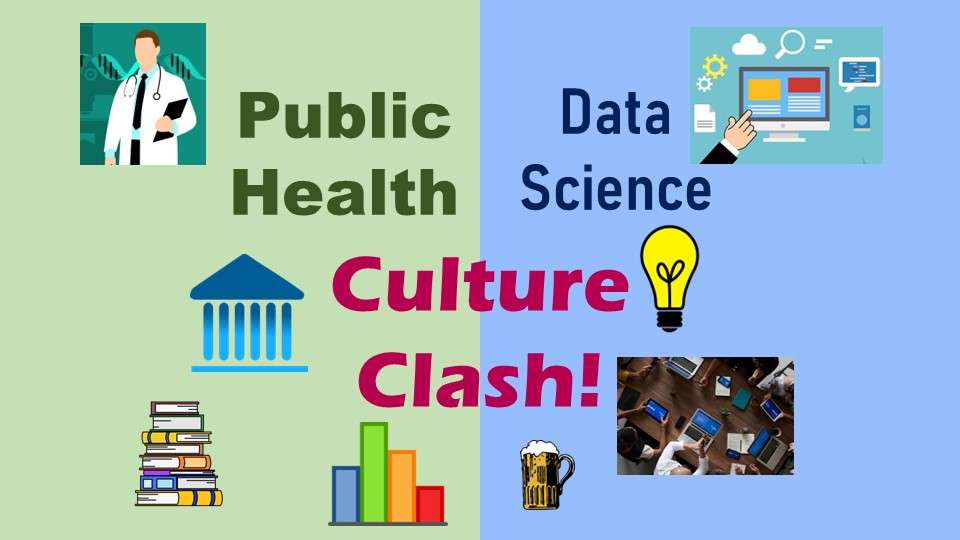Data Science Culture vs. Public Health: How Do You Overcome the Difference?
Data science culture was not really a topic I thought might be a “barrier to entry” or transition from being a public health practitioner doing biostatistics to serving on a data science team doing similar activities in a (hopefully better-paying) job. Data science culture was not really on the brain when I made this video recently that described the overlap in knowledge domains (as I see it) between public health and data science.
Data Science Culture Clash with Public Health
Data science culture arises largely out of business environments that public health practitioners don’t often experience. From 2002 to 2003 and again from 2004 to 2008, I worked in an information technology (IT) department. Here are some features of the culture I remember:
- Fast-paced: We were always running around, acting “AGILE” while trying to keep servers from going down and connectivity up.
- Non-hierarchical: Literally, all hands were on deck all the time. We were adopting new ideas and cross-training each other constantly.
- Independent: While genuflecting to leadership, we spent long hours arguing about First World problems over espresso.
- Inventive: We devoted a non-trivial amount of unpaid time to building group innovations at work just for fun.
Data science culture often clashes with the public health field, which has the following values:
- Cautionary pace: Choices – such as the design of studies, development of policies, or enactment of interventions – need to be made based on a lot of deliberation. This is because public health affects so many people. Of course, this value slows the whole field down. We witnessed this tension globally during the beginning of the COVID-19 pandemic.
- Hierarchy: You need to make sure you follow chain-of-command in all situations, because otherwise, it’s hard to keep track of whether all the protocols are being followed properly. They are there to maintain oversight.
- Protocol: You need to develop processes that are well-documented, transparent, ethical and democratic – which takes a long time, and requires a lot of work from a lot of people with specific public health training.
- Intelligence: Choices about how to proceed are based on evidence from actual research. There is evidence-based decision-making which is deliberate and thought-through. A large amount of value is placed on the results of past research, and the scientific literature.
Should We Adopt Data Science Culture in Public Health?
In my opinion – NO! That is definitely not what I want to say. I think public health culture is perfectly fine – for public health.
But if you are a public health practitioner and you want to work in a data science environment, you will need a way to adopt the culture. And let’s face it – you will not be able to completely throw away your past! Even as a public health data scientist, I’m cautionary, I respect hierarchy, I follow protocol, and I value intelligent decision-making! But I also can operate independently in a fast-paced flat hierarchy on a dime when called upon to innovate on-the-fly when doing data science projects.
To get this way, as a degreed and certified public health practitioner, I had to learn how to be comfortable in both a public health and a data science working environment. It wasn’t easy. However, I had the benefit of having already worked in two different IT departments by the time the term “data science” was invented, in about 2010. And, in both those jobs, I had rich experiences where leaders served as excellent mentors.
How to Get Comfortable in Data Science Culture Today
The only way I think I could have gotten comfortable in data science culture is by having what I would call “data science experiences” like I had in those IT department jobs. In other words, I feel that if you want to become comfortable in data science culture today, you need to have experiences in environments where you are working in a group as a data science team that is fast-paced, non-hierarchical, independent, and inventive. Here are three ways I’ve found that you can do this today:

Get a Data Science Job
I refer to this as the “sink or swim” method. This is where you deliberately comb Indeed.com for a data science job you think you can land with your public health background, and just find a way to get there. Yes, you’ll be way, way, way outside your comfort zone – but you’ll learn quick!

Change your Current Workplace Culture
If you are working at a public health job, depending upon your position or the job, you might be able to introduce some data science culture. When I directed a data warehouse at the US Army, we basically had no choice but to try to flatten our hierarchy, because we had almost no people working there, and a diverse and overwhelming workload. Unfortunately, the culture clash essentially ended the project – the previous leaders were public health people, and had messed the database up so badly we couldn’t get it going again with the meager staff we had.

Consider “Public Health Rebrand to Data Science” Mentoring Program!
As you probably noticed, the first two suggestions are not very attractive choices. “Sink or swim” is totally stressful, and “try to change where you are” often doesn’t work. So as you can see, unless you can find yourself working in an IT department like I did, trying to have “data science experiences” when you are a public health practitioner is difficult.
For this reason, I created a mentoring program specifically for public health practitioners called the “Public Health Rebrand to Data Science” mentoring program. This program provides the opportunity for public health practitioners to have data science experiences outside of their workplace so that they can get comfortable with data science culture while preparing to transition to a data science job.
Data science culture is much faster-paced than the more academic and governmental culture in the public health field. Read my blog post for recommendations as to how public health practitioners can overcome the culture clash!




Hi Monica,
Great article! As data science moves across multiple areas of inquiry, many new issues are cropping up. There was an article in Nature, 17 June 2020 by Heidi Ledford, that raises a few themes similar to yours; such as the development and utilization of theory which in her article is social science theorizing, as non-native activity in data science. Also loved how granular your analysis of the two cultures: public health and data science, as you discussed the operating principles that structure and animate each culture.
Judith
Judith, you always have the most amazing insights!
I think I found the article you are talking about: https://www.nature.com/articles/d41586-020-01747-1
I just skimmed the article, but it has this sort of Vaseline-covered lens about how scientists are branching out and exploring new ways to use data and tools. I think they are describing bold and daring people like you and me! The less bold and daring are actually not keeping up, and are being left behind. That’s the social justice side of it.
In my field of public health, I hear pain points more than I hear about opportunity. I know you are more connected with business and social science people – are they any more optimistic? Have they “bridged” or “transitioned” to more digitally-focused careers/positions, and if so, how did they do it? I would be very interested to learn this!
Love Monika